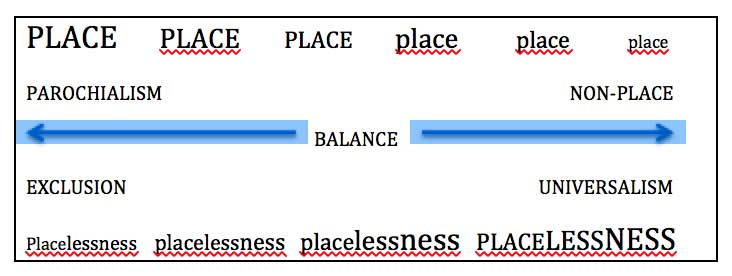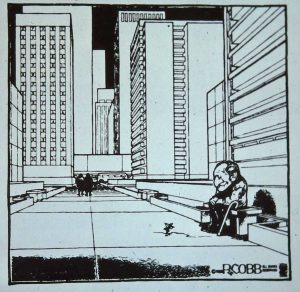My previous post on the Future of Place was triggered by a conference that focused on placemaking and the importance of creating small urban spaces to foster community participation. This is a commendable initiative. However, I think that a much larger challenge for the future of places lies in the uncertain local impacts of economic inequality, climate change, loss of stable jobs, urban growth, water shortages, escalating house prices, gentrification, and all the other social and environmental challenges that seem to be hallmarks of the present century. Cities, neighbourhoods, rural communities and towns, are, and will continue to be, in the front-line of the impacts of these challenges, which will have to be addressed, at least in part, through what I think of as a pragmatic sense of place.
A Definition
By a pragmatic sense of place I mean a locally based, yet outward looking attitude that combines an appreciation of the complex unity of a particular place with an understanding of the diffuse global character of the social and environmental processes that affect it. I wrote about this several years ago (references are at the end) but I want to restate and update some of the ideas I had then, partly because of the very unsettling character of recent political events and partly because these global challenges seem to intensify every year – the ultra-rich get richer, each year is warmer than all previous years, neo-liberal globalization continues apace.

A T-Shirt from 2004, the year Toronto was an epicentre of the SARS (Severe Acute Respiratory Syndrome) epidemic, which was carried from Asia by aircraft passengers. There were several deaths, local confusion and no contingency plan for dealing with a global epidemic.
Historian Jonathan Glover has written: “Most of the time what matters most is the personal and the local. But great public disasters can strike the most unlikely places.” He was referring primarily to the world wars of the 20th century but his comment applies equally well to the fact that even though, for example, climate change may have widespread and diffuse origins, its effects are felt in diverse ways in different places. Miami floods as sea level rises, California withers in persistent drought, ice and tundra melt in the Arctic. Particular places have to respond as best they can to problems that have remote causes, and those responses need to be as varied as the places themselves. One adaptation to climate change does not fit all, and there is no universally appropriate response to economic inequities, epidemics of emergent diseases, or ragged wars and terrorism.
In practical, political terms what this means is that responsibility for dealing with these uncertainties will lie increasingly at the local, municipal level rather than at the national level. Climate change deniers may blather on as international agreements set the tone and establish directions for action, but the real, precautionary work of adaptation will have to be done in places where the immediate effects are most likely to be experienced.
A Note on Pragmatism
A pragmatic sense of place has its philosophical roots in pragmatism, the movement founded by William James and Charles Pierce in the late 19th century as a philosophical approach that looked away from what they regarded as pointless theoretical discussions towards consequence and facts. As our own era slides into post-fact politics this is something that resonates. Pragmatism has been reinterpreted by subsequent philosophers (for instance, Rorty, Toulmin, Putnam, Davidson) as a basis for making decisions about social and political issues in age when there are deep ideological and epistemological disagreements. I particularly like Stephen Toulmin’s idea of reasonableness that suggests a middle way between abstract theory and personal opinion. He argues that “we need to return to the world of where and when, get back in touch with the affairs of everyday life,” and he offers Médecins sans Frontières as an example of pragmatic reasonableness, doing what is possible to save lives and to prevent things getting worse, acknowledging that root causes are important yet dealing with immediate needs.
Balance versus Extremes
A pragmatic sense of place is about getting things done to deal with global challenges, by finding some sort of balance between distinctive local conditions, and universal or global processes. This derives from my understanding of place and placelessness as two inversely related continua rather than an either/or opposition. Everywhere, no matter how placeless, has some degree of distinctiveness; and everywhere no matter how distinctive, shares some standardized characteristics with other places. This diagram gives an indication of what I mean.
 Distinctiveness pushed to the extreme results in parochialism, exclusionary attitudes, even ethnic cleansing. Such attitudes have to be regarded not just as narrow-minded but as naïve in a world now interconnected by electronic communications, air travel and intermittent epidemics of emergent and other diseases. They will not keep out the next flu pandemic nor protect against tidal surges and ideas communicated on the Internet.
Distinctiveness pushed to the extreme results in parochialism, exclusionary attitudes, even ethnic cleansing. Such attitudes have to be regarded not just as narrow-minded but as naïve in a world now interconnected by electronic communications, air travel and intermittent epidemics of emergent and other diseases. They will not keep out the next flu pandemic nor protect against tidal surges and ideas communicated on the Internet.
Standardisation pushed too far leads to non-places and the sorts of universal designs advocated by modernists for social housing, many of which have had to be demolished because they proved to be unlivable. Modernists and the neo-liberal agents of globalization may believe that standardized, universally applied approaches are the most efficient and profitable ones, but cities and communities caught up in the global economy have discovered that too much standardization is a bad thing and a distinctive brand identity provides a competitive edge.
Between the extremes of exclusion and universalism lies a pragmatic sense of place that seeks a reasonable balance between maintaining the distinctiveness of local identity, and doing what it takes to survive in social, economic and environmental systems that are globally interconnected. It requires thinking about what solutions and adaptations will work best here, in this place, to deal with changes and challenges originating elsewhere. It offers no magic solutions, no rule-books, no grand theoretical answers; it does involve a continual effort to find ways that balance distinctiveness and standardization, that aim to reduce social injustices and to reverse ecological deterioration, and to facilitate a locally-based precautionary approach to address emerging global challenges.
Elements of a Pragmatic Sense of Place
There are at least four elements to a pragmatic sense of place:
- like all forms of sense of place, it is ontological, because to exist is always to be somewhere, to be in a place.
- it is focused on the particularity of a place, a quality that is associated with belonging somewhere, being embedded, knowing and being known there.
- it is open to other places because everywhere, in various degrees, is inevitably affected by and contributes to what happens elsewhere.
- it is active rather than passive because to live somewhere inevitably involves taking some practical responsibility for it, and transforming it in some way. This can involve such modest gestures as recycling or cutting the lawn, or more substantial ones such as facilitating or protesting developments, protecting heritage, volunteering to help the homeless, or celebrating place by organizing festivals or installing artworks. These may not be explicitly regarded as aspects of a pragmatic sense of place, but that term does embrace the many acts of place responsibility that happen all the time in everyday life.

This text from Genesis, which I photographed on the wall of a small, remote church in Churchtown on the border of England and Wales, and probably dates from the 17th century, conveys the sense of a place open to and opening to other worlds.
The Openness of Places
A pragmatic sense of place requires thinking beyond the confines of a particular place, beyond the bubble of self, the walls of home, the boundaries of city and region, in order to grasp the differences, similarities and interconnections between places. It regards this place and every other place as distinctive , yet simultaneously open to the world and an opening to the world.
An understanding of the openness of places has probably always played a role in religious and aesthetic experience, even when lives were narrowly confined. The sheer mobility of people nowadays should serve as a foundation for its considerable enhancement. In 2016 there were 3.7 billion Internet users around the globe (Internet World Stats); and in 2015 there were slightly over 1 billion international air passengers (IATA) and 1.2 billion international tourist arrivals (UNWTO). In other words, a substantial minority of the world’s population, presumably the most affluent minority, is either directly familiar with a range of different places and landscapes or electronically linked to them (though I acknowledge that much of this is tempered because it channeled through the non-places of airports, hotel chains and manicured resorts). This range of place experiences needs to be brought to a greater degree of awareness in order to find locally appropriate, balanced and sustainable ways to respond to global changes. A pragmatic sense of place should contribute to this.


Maps of global interconnections. Left, flights in a single day, 2014. Right Facebook in 2013,
Local responses to global problems
Places are territories of local experience that open into the world and are open to global change. Nowhere is an island entire unto itself. The UK Stern Report on Climate Change (2006, Summary of Conclusion, vi) was explicit about this… “Such a radical change in the physical geography of the world must lead to major changes in human geography – where people live and how they live their lives.”

A cartoon by Ron Cobb that conveys the sense that local and natural forces will always push against the forces of uniformity.
In other words, specific places have to be the foundations for resilience and adaptation to economic, social, political and environmental challenges that already confront us in the 21st century, because no matter how diffuse or remote the causes may be, their geographically diverse consequences will be experienced locally and will have to be dealt with locally. For this I believe a pragmatic sense of place is necessary. Whether it is actually called that is unimportant. What matters is the recognition that challenges and changes that originate elsewhere will require policies and courses of action that reflect the distinctive circumstances of particular places yet do not lose sight of the cosmopolitan, interconnected character of the world.
[A Footnote: a week after posting this I came upon the following article about place attachment, sense of place and climate change in the Canadian Arctic that I think reinforces my argument well – Willcox, Ashlee et al, “From this place and out of this place: Climate change, sense of place and health in Nunatsiavut, Canada” Social Science and Medicine, Vol 75, No 3, pp.538-547. Because the impacts of climate change in the Arctic are so advanced what is happening there should serve as a precursor for what might happen in more temperate regions.]
References
• Jonathan Glover 1999 Humanity: A Moral History of the Twentieth Century (Random House).
• Edward Relph, 2008, “A Pragmatic Sense of Place” in Frank Vanclay et al (eds), Making Sense of Place, National Museum of Australia, 311-323
• Edward Relph 2008 “Senses of Places and Emerging Social and Environmental Challenges”, in John Eyles and Allison Williams (eds) Sense of Place, Health and Quality of Life, (Ashgate, 31-44).
• Nicholas Stern 2006 The Economics of Climate Change (The Stern Review)
• Stephen Toulmin 2001 Return to Reason Cambridge MA: Harvard University Press